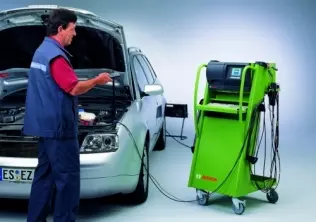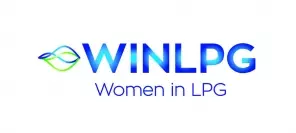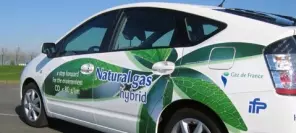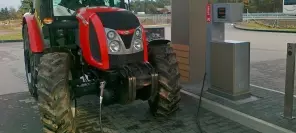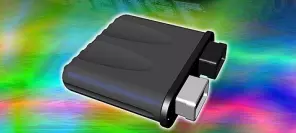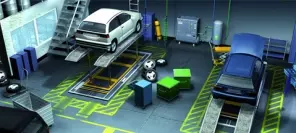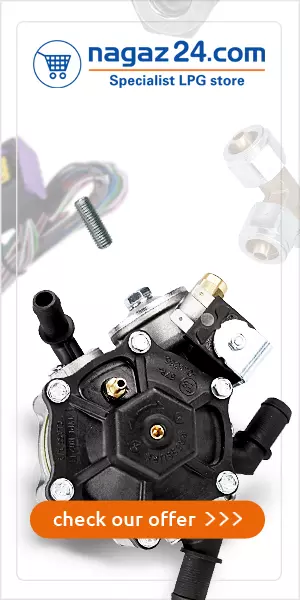- Main page
- Search
- Up to date
- Products
- Technology
- Vehicles
- Video
- Conversion Payback Simulator
Port Injection - Conversion Payback Simulator
Direct Injection - Conversion Payback Simulator
Diesel - Newsletter
Diagnostic devices in a conversion workshop
 loading results...
loading results...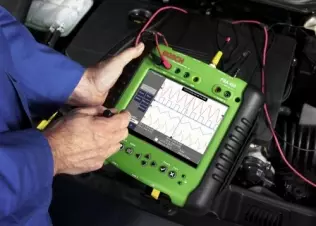 © BoschThe FSA 450 diagnoscope uses a 4-channel oscilloscope and a digital meter with graphic display. It can be powered by its own or the car's battery
© BoschThe FSA 450 diagnoscope uses a 4-channel oscilloscope and a digital meter with graphic display. It can be powered by its own or the car's batteryAutogas systems utilise a fairly simple principle: they intercept petrol injector controlling signals and "translate” them into LPG injector controlling signals. However, since the link is very direct, all fuel and ignition system failures and malfunctions are immediately transferred to the autogas system. This is why autogas installers should be prepared (in terms of equipment and training) to diagnose and maintain spark-ignited engines' all basic systems and components.
Maintenance and repairs of contemporary vehicles are becoming growingly complex as the combustion process supervision and control procedures are gradually computerised in the name of complying with stricter and stricter emission standards. Long gone are the days when autogas system installers could work with hardly any electronic diagnostic equipment, with the sole use of exhaust-gas analysers. It was possible when 1st generation LPG systems, devoid of electronic components, were the name of the game, but it's no longer possible today.
 © BoschThe FSA 740 Edition diagnoscope allows to test the engine and measure signals from the ignition system, ignition advance angle or oil temperature. It also features a signal generator
© BoschThe FSA 740 Edition diagnoscope allows to test the engine and measure signals from the ignition system, ignition advance angle or oil temperature. It also features a signal generator
Introduction of the first LPG ECU's was the effect of the advent of exhaust-gas catalysers and petrol injection systems. 2nd generation autogas systems came to be and with them came electronic LPG flow control, even though the gaseous fuel was still fed into the engine by means of a mixer rather than injector. Those second-gen systems use lambda sensor signals to calculate fuel dose, so the sensor's proper functioning is crucial for the LPG system's correct operation. Second-generation systems are rare today, but should one be installed, the lambda sensor must be tested for malfuntions. A simple voltameter will do.
Along with 2nd generation systems first maintenance and calibration software was introduced. It was possible to display and manipulate basic working parameters of the system and the engine, including lambda sensor presets. The 3rd generation systems, which were soon to follow, were actually a brief transition between vacuum systems and electronic multipoint sequential systems (4thgeneration) and are next to impossible to come by these days. They require custom software and exhaust-gas analysers for fuel dose regulation and maintenance.
Today
Second-gen systems are now obsolete and fourth-gen ones have become common. The latter ones no longer need lambda sensor signal to work properly, although the sensor as such must be kept operational at all times to keep the engine work right and maintain emissions within limits. Still, it's vital that engine condition be comprehensively checked prior to conversion. Which is actually quite easy these days – since OBD (on-board diagnostics) is obligatory on all multipoint-injected cars, it's not necessary to test all elements separately, one by one. Using an OBD scanner will help locate all malfunctions if there are any and assess the motor's state.
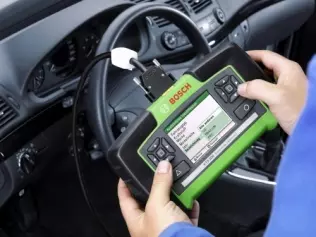 © BoschThe KTS 200 failure tester enables comprehensive ECU diagnosis. It offers information such as diagnostic plug location or plugging scheme for a given car model. It needs no batteries of its own as it can be powered directly from the diagnostic plug
© BoschThe KTS 200 failure tester enables comprehensive ECU diagnosis. It offers information such as diagnostic plug location or plugging scheme for a given car model. It needs no batteries of its own as it can be powered directly from the diagnostic plug
And so the OBD scanner is one of the most important and most useful tools in an autogas conversion workshop. It allows to see if the engine works right as well as to edit and delete errors stored in the OBD system's ECU. OBD scanners are portable, which makes it possible to diagnose the engine while driving, under different loads and conditions. Scanners are also helpful when it comes to 4th-gen system calibration – autogas dose should be set in such a way that OBD corrections remain unchanged as compared to those on petrol. Thanks to this the engine works optimally regardless of conditions and the "check engine” control doesn't light up.
Failure tester
The functions of OBD scanners are also integrated into universal failure testers, which are also able to diagnose other ECU's of the car. They are helpful when it comes to locating petrol fuel system malfunctions, which makes them crucial tools for autogas system installers. Such testers have become pocket-sized and mobile lately and are very convenient to use. They often feature the basic funtions of a diagnoscope (with oscilloscope and meter), thus becoming even more versatile.
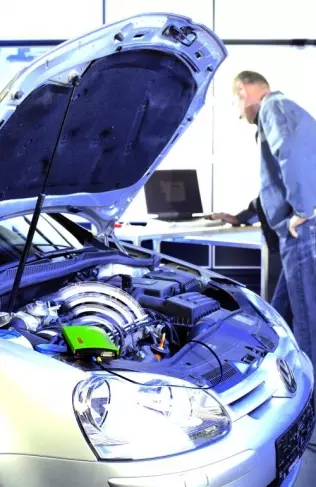 © BoschThe wireless KTS 540 module with a USB/Bluetooth adapter helps use a PC or laptop computer as a diagnostic tool. It features a multimeter to measure current intensity, resistance and voltage
© BoschThe wireless KTS 540 module with a USB/Bluetooth adapter helps use a PC or laptop computer as a diagnostic tool. It features a multimeter to measure current intensity, resistance and voltageUniversal engine diagnoscope
Engine diagnoscopes also come in handy, even though they are stationary. They normally feature oscilloscopes and advanced digital meters and are used for testing electrical wirings, sensors and other systems and components used in contemporary engines. Various probes, which are a diagnoscope's standard equipment, are used for testing particular elements. Dignoscopes can also feature signal generators, making it possible to test sensors and their circuits without disassembling from the car. Standard traces can be imposed over actual traces, which allows quick assessment of tested circuits' functional correctness.
Autogas system calibration software
Certain autogas system ECU's work similar to their petrol counterparts and store appropriate error codes whenever the LPG system malfunctions. By using custom software (designed for a particular ECU) it's much easier and quicker to diagnose and eliminate problems. Error codes are interpreted with the use of calibration software for a given system (normally installed on a laptop computer connected to the ECU by means of a custom, system-specific interface).
Storing error codes is a function of the LPG ECU software. Certain ECU's offer the extra function of displaying error codes through pulsating of the LED on the switchover consoleinside the cabin. This means the user (driver) can read the error code themself and inform the installer before actually coming to the workshop. The latter can thus get prepared for any repairs (e. g. order necessary parts) beforehand to cut the downtime.
Obviously, an exhaust-gas analyser is an absolutely vital piece of equipment in any autogas conversion shop. It's used for testing emissions once the conversion is complete and then every time during regular maintenance. Exhaust-gas composition must comply with legal standards applicable.Should certain substances be over the limit, the autogas system might not be working properly.
All in all
In order to install and maintain an autogas system correctly in a modern car, a number of complex diagnostic devices is required. They aren't cheap, neither is keeping them in good running condition and up to date in terms of software. However, the more there are in a workshop, the broader the scope of services to be offered (e. g. diagnostics and repairs of all sorts of systems used in contemporary vehicles). The investment could well be worthwhile, for an LPG system installer could become an interesting alternative to an authorised service station when it comes to repairing something, not necessarily just the autogas system.
You may also find these interesting:
 loading results...
loading results...

